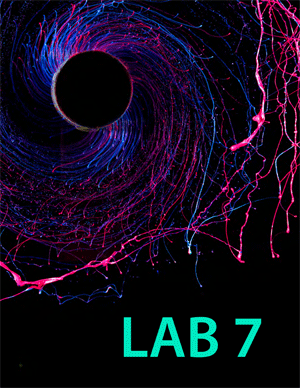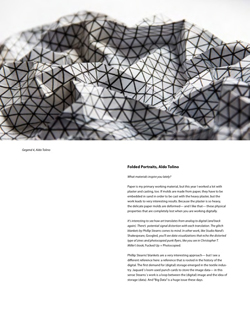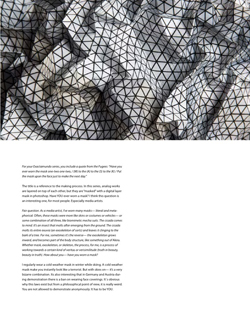What materials inspire you lately?
Paper is my primary working material, but this year I worked a lot with plaster and casting, too. If molds are made from paper, they have to be embedded in sand in order to be cast with the heavy plaster, but the work leads to very interesting results. Because the plaster is so heavy, the delicate paper molds are deformed— and I like that— these physical properties that are completely lost when you are working digitally.
It’s interesting to see how art translates from analog to digital (and back again). There’s potential signal distortion with each translation. The glitch blankets by Phillip Stearns come to mind. In other work, like Studio Nand’s “Shakespeare, Googled,” you’ll see data visualizations that echo the distorted type of zines and photocopied punk flyers, like you might find in Christopher T. Miller’s book, Fucked Up + Photocopied.
Phillip Stearns’ blankets are a very interesting approach— but I see a different reference here: a reference that is rooted in the history of the digital. The first demand for (digital) storage emerged in the textile industry. Jaquard´s loom used punch cards to store the image data— in this sense Stearns´s work is a loop between the (digital) image and the idea of storage (data). And “Big Data” is a huge issue these days.
For your “Exactamundo” series, you include a quote from the Fugees: “Have you ever worn the mask one-two one-two, / (M) to the (A) to the (S) to the (K) / Put the mask upon the face just to make the next day.”
The title is a reference to the making process. In this series, analog works are layered on top of each other, but they are “masked” with a digital layer mask in photoshop. Have YOU ever worn a mask? I think this question is an interesting one, for most people. Especially media artists.
Fair question. As a media artist, I’ve worn many masks— literal and metaphorical. Often, these masks were more like skins or costumes or vehicles— or some combination of all three, like biomimetic mecha suits. The cicada comes to mind. It’s an insect that molts after emerging from the ground. The cicada molts its entire exuvia (an exoskeleton of sorts) and leaves it clinging to the bark of a tree. For me, sometimes it’s the reverse— the exoskeleton grows inward, and becomes part of the body structure, like something out of “Akira.” Whether mask, exoskeleton, or skeleton, the process, for me, is a process of working towards a certain kind of veritas or verisimilitude (truth in beauty, beauty in truth). How about you— have you worn a mask?
I regularly wear a cold weather mask in winter while skiing. A cold weather mask make you instantly look like a terrorist. But with skies on— it’s a very bizarre combination. Its also interesting that in Germany and Austria during demonstration there is a ban on wearing face coverings. It´s obvious why this laws exist but from a philosophical point of view, it is really weird. You are not allowed to demonstrate anonymously. It has to be YOU.
Fascinating. I’m curious— coming back to art— if, during a performance, a person wears a 3D-printed mask formed from a 3D scan of their own face— are they hiding? Or performing as themselves?
We have no other option than to perform a certain role or idea of ourselves. Not only in art (e.g. a performer plays a certain role on a stage), but also in our everyday lives. You are a different parent from a different accountant from a different game character. If a mask is 3D-printed or made from plaster and hand-painted does not make a big difference here. Markus Schroer and Stephan Moebius have collected texts on “social types” in a very interesting book, but, sadly, I don´t think it´s available in English.
What kind of books are on your bookshelf?
I love books and I have a lot of them (almost too many)— mostly art, novels, and books on philosophy. My all time favorite is Transfer by Peter Erni, Martin Huwiler, and Christophe Marchand. The Swiss make the best books. It’s a book on architecture, essentially, but it’s such a wonderful mixture of images, quotes, and texts around the topic— totally different than any other book in this genre. It’s wonderful in any way— sadly, it’s only available in German. But, of course, there are many, many wonderful works on philosophy, too. Beschleunigung by Hartmut Rosa, or Wofür es sich zu leben lohnt by Robert Pfaller. Slavoj Žižek´s works and films are also very interesting.
There’s been a recent controversy with Ellen Page, who modeled for a video game (Beyond: Two Souls) in which there’s a nude shower scene. The model in the nude scene is actually CGI, but the model’s motions are based on the actress Ellen Page’s movements. Which raises the question— who is posing nude?
This is a particular feature of the digital. Here we have the possibility to split the motions and the visual appearance of a (real) character; we can use captured motion information to control an avatar. Essentially it boils down to the question: “what does the word ‘real’ mean?” Heinz von Foerster and the radical constructivists have done a lot of research on this issue and questioned the concept of reality as we understand it. I think the most real thing a human can feel is pain.
Pain and pleasure. Both define us as humans. One can’t exist without the other. Your series, Transparency International— can you talk to us about it?
You have to be familiar with digital image processing to understand this one. In programs like Photoshop, “transparency” is represented through a checker of white and grey squares. Transparency isn´t meant to be transformed like you can see in my work, as it is only the representation of “void.” It is like dividing by zero. You can not fold transparency. It is always flat.
Fascinating. So it’s more of a theoretical space for content (versus content), in the same way that a color space is a theoretical spectrum of colors (examples: sRGB for the screen, Adobe RGB for print, or LAB as an international meta-color-space). Coming back to transparency— once you stack multiple layers of variable transparency, sometimes a composite, or a sense of volume, emerges. Do you see your work as existing in flatland or 3D space?
I would say it’s a central question of my work to research this relation between three-dimensional space and “flatland.” Because I work a lot with textures, it´s very often unclear if the objects are really three-dimensional or flat. But it’s exactly this uncertainty that interests me. It´s very similar to Schrödinger’s cat experiment— the objects are both flat and dimensional at the same time. Of course these illusions of space have a long art history, especially in a religious context like trompe-l’œil. My central medium, paper, is flat, but it is not two-dimensional. It´s very thin. Try folding a piece of paper in half 7 times, and you instantly amplify the flatness to volume.
Perhaps similar to the way space/time folds, but instead of adding volume, adding parallel possibilities? The Schrödingers cat experiment has always fascinated me. There’s an element of that in art— is it art? not art? art? not art? Depends on who is looking, and when and how the looking is done. Much like the Observer Principle. Speaking of quantum theory, have you checked out the new quantum computer (built by NASA, Google, and D-WAVE)? Instead of running binary code (1’s and 0’s), it uses 1’s, 0’s, and q-bits (where a q-bit is 1 and 0 at the same time).
The idea behind the cat experiment is to show the concept of uncertainty. A cat is dead, or it’s not. The interesting role lies in the role of the observer. The look of the observer changes the experiment. The observer, or to be more precise, the observation of an observer, play a central role in cybernetics and also in the works of Niklas Luhmann. By (re)folding portraits, my work has a lot in common with this observation of the second order.
A transformation through added dimension?
I’m very much interested in an analogue way of transforming images and the relation between image, surface, and texture. By taking portraits as a base for the transformation, the faces are massively deformed, but still in a very precise and regular way— by using a triangular grid. This has a lot in common with the techniques of low-poly modeling and texture mapping, which are digital techniques essentially. But these paper objects or “deformations” can also be seen as masks. Sometimes, a mask better represents the self than a real, unmasked face. A mask is not only about anonymity. The greek root anonymia literally means only “without a name”, or to be more precise “being publicly unknown.”
Does true anonymia exist anymore? Or is complete transparency the new anonymia? I’m reminded of Evan Ratliff’s attempt to disappear from social media, or the inverse: Feltron’s personal annual report.
At this point, Heisenberg´s Uncertainty Principle kicks in: you can´t be both, anonymous and a media performer. But it´s interesting that more and more of these philosophical questions arise: what is “technology,” and where has it turned against us? The terminator principle. Many of us were fascinated from the new possibilities that the “new” media landscape brought us, and are now experiencing a kind of boomerang effect. But people are not satisfied with these kinds of situation where they have to pick: they want both. Slavoj Žižek has written a lot on this consumerist development: chocolate without sugar, beer without alcohol. It would be possible to disappear from the grid, but you´d have to sacrifice quite many convenient things that you are used to. And sacrifice is a religious idea essentially.
Sacrifice can be a religious concept. Or, in chess theory, you have the gambit, which is a short-term sacrifice which leads to long-term gain. Coming back to social media, it’s been estimated that up to 50% of all social media profiles are sock puppets (fake accounts). It seems there are pros (and cons) to both anonymity and transparency. Recently, Facebook’s Natalia Rojas unveiled an interactive image / data visual (Faces of Facebook) that dynamically displays all 1.2+ billion Facebook profile photos. What kind of effect does this have on the global consciousness?
The work of Natalia Rojas is very interesting because it has to do with noise. In the beginning of the net, there have been very optimistic predictions that the net will democratize the way we discuss and access information. But these hopes became only partly a reality. Opinions on the net generate a lot of noise. Also, because of the anonymity on the net, discussions a very, very difficult. Try to discuss a certain topic over a mailing list or on an internet board with only 5 others— it’s impossible. It´s exactly that noise that is visually represented in Natalia’s work. There isn´t an established connection between opinion (on the net) and democracy, yet so many communications remain in the stadium of noise. There is a strange loop between anonymity and noise.
Speaking of noise. Cymatics. Could this metaphor be applied to social media analysis? Where resonance, mirror neurons, flocking analysis, meme theory, sorting algorithms, and noise-reduction signal processing allow a deeper understanding of how something like a zeitgeist emerges?
Now that is a HUGE question! As mentioned before, there is a growing insecurity building up where technology is leading us. Concerning zeitgeist, the younger generation will decide what way they will adopt and use new media. A youth subculture that rejects media technology is long overdue. Like the straight-edge movement, but concerning technology. The difficulty here lies in the interrelation between private and public communication and media use. It has become almost impossible to quit technologies in the daily work environment.
What do you feel are the biggest concerns or insecurities around new media?
I think the biggest issue is that we have become totally dependent on these new means of communication. Not only for accessing knowledge, but also concerning money and banking. We are going from printing money to simply adding zeros. I doubt that that´s a good idea on the long run.
Fascinating. Reminds me of Mark Wagner’s work with currency. For Gegend, you included an etymology of the word “area”:
Area: The term derives from “against” and is from “the opposite field” (or contrata regional), migrated as lehnbildung from Latin contra. The Latin root persists in languages such as Italian (contrada), or, in French: contrée, derived from English: Country.
In the series Gegend, a sculptural landscape is created by folding a piece of paper. But the piece of paper is an image already. It is an image of another folded landscape. I use this recursive technique a lot— it creates strange and very interesting loops between form and image. The title is German. Gegend could be translated with “area” or “territory,” but a precise translation is quite difficult. Here, it is a reference to the conception of “landscape,” which always related to memories of a certain place or area. Gegend also implies a certain familiarity with a geographical area and its habits and traditions.
Brings to mind psychogeography. Do you find your artwork is influenced by the area that you work in and the geography that surrounds it?
Perhaps not the portrait series, but the works that look like aerial photos (e.g. the “Gedeihen” series) of imaginary landscapes surely are. I guess primarily because I don’t live in a city— I live on the countryside in Austria, surrounded by forests and mountains. Twenty years ago, this would have been difficult because of the isolation, but since the rise of the net, you are online anyway. In this way, my works are a comment on how the concepts of geography and proximity are transformed through the digital age.
Perfect. What inspires you in the morning?
Simply the knowledge that I am in a quite privileged life situation where my life is going well and I am able to work as an artist. •



